Recently I mentioned two unintentional non-LDS witnesses of the Book of Mormon, Michael B. Morse, the non-LDS man who saw Joseph’s translation process underway a number of times, and Josiah Stowell, who was one of the first people after Joseph to heft the plates. Here’s one more to consider. This comes from Larry E. Morris, A Documentary History of the Book of Mormon (Oxford: Oxford University Press, 2019), pp. 265-6. This passage can also be viewed at Google Books. A screenshot from Google Books is below, followed by the text.
The text:
Chenango Union Interview with Mrs. Doolittle, April 12, 1877.
Source note: “Early Days of Mormonism,” Chenango Union, Norwich, N.Y., April 12, 1877.
The Binghamton Republican publishes
some personal
recollections of Mrs. Doolittle, a lady seventy-five years old, who is
now visiting with her son-in-law, Chief of Police Johnson
of that city. She was personally acquainted with the first wife of
Joseph Smith, the Mormon prophet, Miss Emma Hale, whom he
married near Susquehanna, Pa.From her statement it appears that Joe came to the neighborhood of
Susquehanna to dig for gold, and made several excavations for
that purpose, but it never was known that his labors in that direction
were rewarded. While thus employed he became acquainted
with Miss Hale, whose parents opposed the proposed marriage, and the
young people eloped to Windsor, where they were married.They returned and settled down upon a farm adjoining the lands of Mr. Hale and Mr. McKune. There was already a small house upon
the farm, a story and a half frame building, and Joe put on a small addition. The farm and the house is now the property of
Benjamin McKune, a grand-son of Joseph McKune. This same McKune farm is again becoming somewhat famous in consequence of
preparations to bore into it for oil a short distance from the prophet’s first domicile.While Joe was upon his farm he had the Mormon Bible. Whether he professed to find it before or after marriage Mrs. Doolittle
does not remember. Her grandfather was once privileged to take in his hands a pillowcase in which the supposed
saintly treasure was wrapped, and to feel through the cloth that it had
leaves. From the size and the weight of the book, Mr. McKune
supposed that in dimensions it closely resembled an ordinary Bible in
the print of those days.
Further up the river they have also reminiscences of Joe Smith, which
continue Mrs. Doolittle’s narrative. In the town Alton, Chenango
County, not far from the Broome County line, is a small lake nestled in
the hills, and a portion of it is in sight of the Albany &
Susquehanna Railroad. It is said that Joe Smith baptized his first
Mormon converts there; and it is claimed that the Mormon Church was
really begun there, instead of being founded at Manchester, Ontario
County, the home of the Smith family, and where the first printed
copies of the Mormon or Golden Bible were distributed about ten or
twelve years after the prophet’s first appearance in Susquehanna County
to dig for money.
So whatever the gold plates were, here at least is a witness from a neighbor that Joseph had something about the size of a family Bible that had leaves he could sense through the cloth that wrapped it. This is consistent with what other witnesses experienced, including through touching, seeing, and hefting. Theories that Joseph just had a chunk of lead don’t pass muster — not to mention that Martin Harris pointed out that Joseph didn’t have the resources to even acquire that much lead. Something else was going on here. Mass hypnosis of neighbors, too, perhaps?


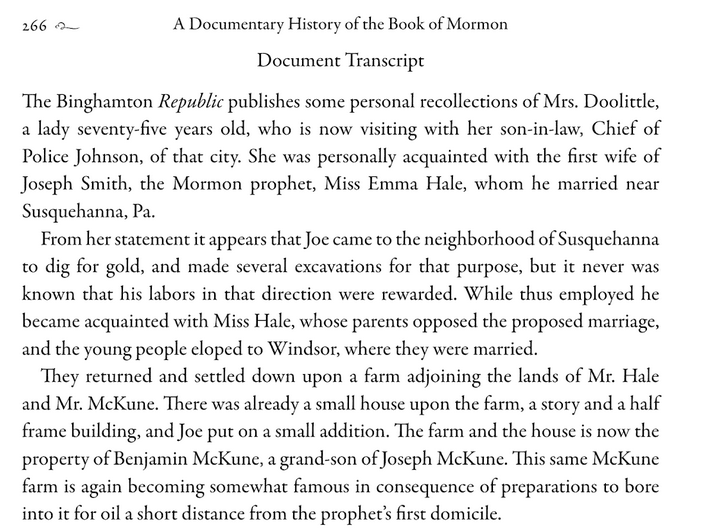
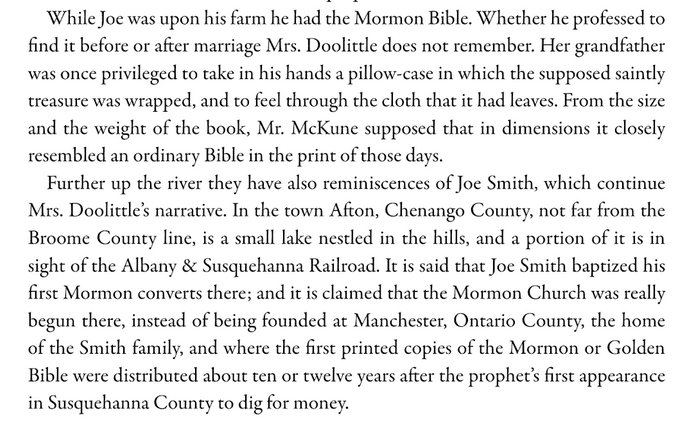
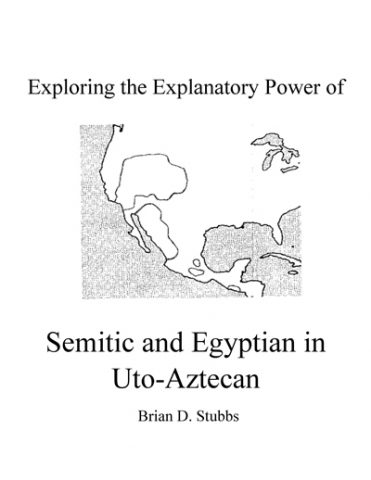
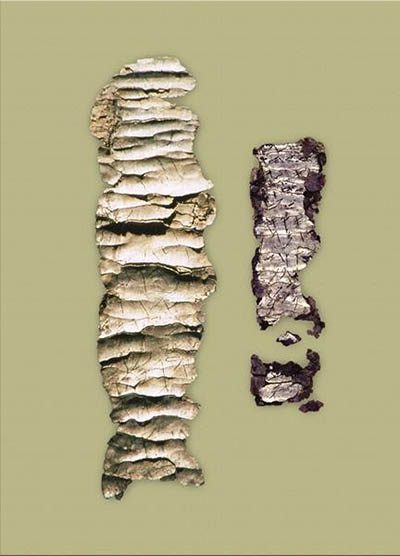
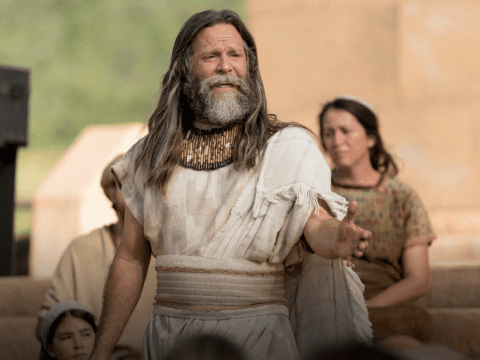








Maybe "mass hypnosis" is how everyone saw the Voree plates, Kinderhook plates, and Zelph's bones.
Another witness who didn’t actually see the plates. That doesn’t exactly help your case, Jeff.
Joseph Smith: Hey, bro, guess what—I found some golden plates!
Curious Acquaintance: Wow! Show me!
JS: Well, um, I can’t show them to you, exactly, because, um, they’re, uh, God doesn’t want me to show them to just anyone, yeah, that’s it. But here, I’ll let you heft them while they’re wrapped in this pillowcase!
CA: That’s good enough for me! Wow, they feel like metal leaves! Joe, you’ve got a bit of a reputation hereabouts as a money-digging grifter, but I believe you anyway! This must be exactly what you say it is! And just for the record, I am not a superstitious fool!
C’mon, people. There’s no more reason to believe the LDS origin story than that of the Seventh Day Adventists. Joseph Smith had visions, Ellen G. White had visions—sure they did. And Mary Baker Eddy had Malicious Animal Magnetism.
Sure.
People will believe anything. Just look at Scientology. Look at Jim Jones. Look at the Heavens Gate cult.
I know, I know…. Out of all the thousands of Christian sects that have splintered off over the centuries, Jeff has been fortunate enough to find the one and only true church.
Sure.
— OK
Jeff, thanks for sharing interesting excerpts like this from the book: "A Documentary History of the Book of Mormon". It sounds like it would be an interesting read. I appreciate how more and more historical details are coming to light with regards to the early history of the Church. I also appreciate how open most church members (at least ones that I'm aware of) are to having any and all such historical information available for everyone. There really is nothing hidden that will not be brought into the light. We see that literally being fulfilled in this age of modern technology where so much information is becoming available from a historical written record stand point. It is also interesting how each side (critics vs believers in the faith) take opposite slants on any new information as it becomes available. One thing that really strikes me often is how gracious Church members are (in general) to those who disagree with them. Your blog is an example of this, how you give critics their say as well in the comments section, and that when you give the occasional reply, you do so in a respectful, courteous manner.
Phil, I agree that Jeff is a fine blog host.
— OK
Phil – Jeff's blog is the only example
"From the size and the weight of the book, Mr. McKune supposed that in dimensions it closely resembled an ordinary Bible in the print of those days."
Sounds like a bible in a pillowcase to me. You've long questioned Joseph's access to a Bible in the early days of translation. This sounds like confirmation that he had one. . .
The term dimensions is used to describe spatial measurements (width, length, depth) whereas weight is used to describe force (Newtons in the metric system). While the dimensions were similar to that of the Bible, the article did not say that the weight was similar to the Bible. Do you see the difference?
Steve
Steve,
"From the size and the weight of the book, Mr. McKune supposed that in dimensions it closely resembled an ordinary Bible in the print of those days."
Sorry to burst your bubble after you provided such insightful instruction on science and such. . .
I'm not sure the author had your scientific acumen. . .
If the object in question were the size of an ordinary Bible, and it consisted of gold plates, then its weight would have certainly been impressive enough to have been worth mentioning.
That the weight was not mentioned suggests that the object weighed about as much as an ordinary Bible and thus was not made of gold.
Also, of course, if Joseph’s insistence on not allowing any ordinary inspection doesn’t make you highly suspicious, I don’t know what to tell ya.
— OK
The weight is an issue that should not be glossed over. Even for a person who believes the Joseph Smith story, this account provides little to support it.
No bubble burst (there wasn't a bubble to begin with, no wind in my sails, etc). I have never ever in my whole blessed life seen dimensions associated with weight. This would be a first. No scientific acumen is needed to know that dimensions refer to some sort of spatial measurement. Ikea instructions show length, width, depth as dimensions and never weight. I do agree that it is odd that the weight was not noted but nevertheless, dimension does not equate to weight. And, this would be the only instance where the weight of the golden plates was compared to the weight of a Bible if indeed you want to make such a comparison to this statement about the golden plates.
Steve
Since this was a second hand account, the omission of the weight of the wrapped item, whether heavy or light, is an omission in transmission. The realtor did not hold it herself, so had no direct knowledge of the weight.
But the weight was mentioned, and contributed to the comparison of a Bible! Look, as someone who believes the Book of Mormon has divined origin, I say this "witness" is terrible. It lends no credence, suggests deception, and is like third hand. Not meant personally, but poor apologetics is worse than no apologetics.
Whatever.
The "divinity" of the Book of Mormon is irrelevant to Mormon theology. Though the Book, and Mormons in general, harshly criticized the Catholics, shortly after forming their religion they soon discovered the challenge of melding a theology with a social group and quickly and ironically adopted the Catholic concept of Papal Supremacy, only now the Pope is in Salt Lake instead of Rome.
Even if the Book could be proven false, the Mormon belief that only Mormons possess valid/proper priesthood would still remain. In fact, if the John the Baptist apparition could be proven false, that would still not address the Mormon belief that all other Christians do not have valid priesthood. The odd way in which John Baptist did not baptize Joseph Smith and Oliver Cowdery, and the way in which Smith and Cowdery give each other the priesthood, then baptize each other, then give each other the priesthood again, strongly suggest they may have felt a spiritual presence, but no other physical being was there, only years latter conveniently deciding that the presence they may have felt was John the Baptist.
Even if the Mormon belief that no other Christians possess valid/proper priesthood could be proven false, Mormons would still have priesthood by extension of Christendom. This is essentially Jeff's position. The truth is, he doesn't care if Joseph Smith made it all up, because of what the church teaches now is loving your family, being nice and helping people.
Since this was a second hand account, the omission of the weight of the wrapped item, whether heavy or light, is an omission in transmission. The relator did not hold it herself, so had no direct knowledge of the weight and could have forgotten that detail, if it had been told to her.
Joseph Smith and Oliver Cowdery each left very detailed descriptions of their encounter with John the Baptist, including recounting John's paraphrasing of Malachi Chapter 3 concerning the Sons of Levi making an offering in the temple in the last days. They did not have a "feeling" but saw and heard John and felt his hands on their heads. The fact that he directed them to first baptize each other, then ordain each other with priesthood authority, established the proper order that is followed consistently to this day. The two witnesses also affirmed their ordination under the hands of the physical Peter, James and John, and six years later of a personal visit with Christ and the receipt of further authority under the hands of Moses and Elijah. You may not like what they saw, but they affirmed throughout their lives that this was something they experienced with their eyes, ears, and bodies.
Steve,
Quick internet search:
form or shape (something) to particular measurements.
"the seats and backrests are dimensioned to withstand high loads from items such as unsecured luggage"
Based on the example above, it seems the definition of dimension is somewhat fluid–in this case referencing strength. It's obvious from the context that weight was one of the "dimensions" being considered.
Dimension is also a way to reference a different state of being or time, so not just width, depth, height (see alternate dimension).
Coltakshi –
Why would I not like what they saw? Do you need me not to like what they saw? For all I know they saw John the same way they saw an unnamed angel of the Lord baptize John when he was 8 years old (DC 84).
Given the account was so detailed, can you tell me if John was still wearing the camel hair toga? People who tell detailed accounts don't usually wait years before even mentioning "what they saw" to a single soul or note in a journal entry. In your "detail" of dialogue, John didn't warn them of persecution and not to tell a single soul for several years, but that is what they did anyways. Then there is the fact that you admit that John the Baptist told them the proper order, but didn't actual do the proper order himself. Do as I say, not as I do, because I am not actually physically here. The miraculous part is that instead of raising your critical analysis and spidey sense, it just convinces you more.
Point of theological detail: Who was the Melchizedek priesthood holder that gave Jesus the Gift of the Holy Ghost in order to fulfill all righteousness? After all the laying on of hands for the Gift of the Holy Ghost is an ordinance of the everlasting gospel and not optional.
Point 2 of theological detail: If John was baptized at eight, and Jesus at the age of 12 was already an expert on the law, why did he wait until he was 30? If his mom forgot when he was 8, at least by 12 he was already doing his own thing without consulting his mom.
Of course the list of genuine theological discussion could go on, but disingenuious Mormons wish only to argue things like the divinity of the book of Mormon and tell other people they are interpreting the spirit wrong. Such is the behavior of people who are in truth are obessed with exercising power and control over others and not genuinely concerned with helping them. Easy to join, easier to be born into, hard to leave. The vast majority of the 60000+ missionaries are there because they were raised being told they would go to hell they didn't. As you all know, the divinity or not of the book of Mormon has zero to do with the religion.
Fair point about the problems in this statement. Since it's reported second-hand, there's certainly room for error in what we have reported — something I'm sure we all experience almost every time we hear someone tell a brief story to others that we originally told them. So easy to get minor details wrong that might be significant to us. Based on his account, it may be that he's describing simply touching the plates through the cloth. Did he also heft the cloth a bit to actually feel its weight? Perhaps.
But it's the DIMENSIONS that are said resemble the Bible, and we don't usually use that word to refer to weight. Ditto for the 19th century, where many references refer to the "weight and dimensions" of various objects. So in its dimensions, whatever Joseph had resembled a Bible, he supposed. But why say that he inferred this from the size AND weight? That's unclear or unnecessary (size alone would suffice to make that statement). Sloppy thinking or a slip of the tongue or pen?
But from his words and their tone, it seems clear that he was not saying, "Hey, I could tell it was merely paper, folks. Just a family Bible!" But rather, he observed that it was comparable to a family Bible in dimensions and had "leaves." Not the word I would expect if it were just paper pages or paper sheets. If it was a paper Bible, I think he would have said that and been a little more sarcastic in his assessment. Instead, the statement seems to suggest that he wasn't sure what was there, but was not calling out Joseph for pretending an ordinary paper book was made of gold.
His observation is of interest and does not support allegations of fraud, but does support the idea that Joseph had something physical. With leaves. And something, obviously, that didn't lead people to immediately conclude that it was just a paper Bible. What wowed roughly 20 witnesses who saw, touched, or hefted the plates could not possibly have been a Bible, a block of wood or a lump of stone or lead.
There's nothing to say he had the same thing in the pillow case, the box or under the sheet every time. The story goes that he forgot to have a box made for the plates–maybe his stand-in for the plates wasn't yet finished either, so he used what was at hand that had the right size and shape. Weight would be a secondary consideration.
Definition of leaf:
a single thickness of paper, especially in a book with each side forming a page.
synonyms: page, sheet, folio, flyleaf
"as he handled the book, a sheaf of loose leaves fell from the back"
Remember also, a contemporary of Joseph Smith was Walt Whitman, who produced the work Leaves of Grass. This is a play on the word Leaves, which means foliage of a plant, but also the pages of a book.
The description sounds like what you would hope from a witness–"just the facts ma'm" with no embellishment. Again, you seem to have provided better evidence that Joseph had a Bible on his possession in backwoods Pennsylvania–something you made out to be a near impossibility–than that he had a "golden bible."
Sorry for not responding earlier. Here in China right now it is very difficult to access anything related to Google (including Blogspot) as the Great Firewall is being ramped up to enhance national security at a time of major political meetings. The VPN tools lilke ExpressVPN that some bloggers allegedly and shamefully use to make posts and comments have been unusable most of the time these past few days, so I hear.
Was it fraud for Moses to use Pharos priest's own magic trick he learned growing up in the palace and turn a staff into a snake? Being that Jeff's believes the raw meet Lehi's group ate was something more scientific like jerky and the great flood was something more scientific like a local flood, I doubt Jeff believes Moses or the "false" priests also turned a staff into a serpent.
I doubt Jeff would call Moses a fraudster. But hey, Jeff also says fraud doesn't make a prophet a false prophet, so why does he care if it was fraud or not. According to jeff, even if the plates were a fraud, joseph Smith could still be a prophet.
I do not see how Joseph Smith could not sincerely believe he had a prophetic ability. Too many close people around him were telling him he did from birth. Only the most Socratic personalities do not believe the Oracle when the Oracle says they the smartest person in town.
Some treasure diggers sought him out, not the other way around. The townsfolk were having angelic visions even without Smith. So it is all understandable and not at extraordinary for the environment. Smith only ventured into the urim and thummim because another treasure seer said he could see spectacles with the plates Smith didn't see in front of other people, embarrassing Smith as a weaker seer and forcing Smith to declare he could see the spectacles also.
The same people told Smith that he possessed a divine ability, also taught Smith it was ok to use trickery, even nephi said it is ok to dress up and impersonate a state authority (trickery) to get to religious ends. If burrying a feather and finding it with the seerstone in front of Josiah stowell is ok, then it is ok to imitate the practice with fake plates the way Jeff says James strange proved is 100% possible.
Jeff continues Smith's tradition of trickery to achieve religious ends with his well documented pattern of deceit. If Jeff is not a fraudster then neither is Smith. Modern Western courts agree, when it comes to religion, fraud is not possible.
Not true. Her one brief sentence fits other descriptions. But while you are at it, please tell tapir Dan that the BoM doesn't talk about riding animals. Bytheway, did you Nephi's horse's name was untoyou. He is always telling it wo wo.
Anon at 10:25 PM, March 05, 2019
Interesting. I guess it proves my point still. Strength is not weight. Given the materials needed to build such a seat, the dimension for appropriate strength would be 1 foot instead of 1 inch.
Steve
You're right. Weight isn't a dimension. It has absolutely nothing to do with the description of the book in the pillow case. I'm sorry I doubted you Steve.
Sometimes we get so bogged down with this or that detail we miss some of the more obviously modern features of the Book of Mormon.
A case in point that leaps out at any biblically literate reader is what in my American literature classes I call the PTP or “proof-texting preacher” voice. When for example we read 1 Nephi 12, we see a hodgepodge of allusions to the following:
— Book of Genesis (sand of the sea, mist over the face, broken up)
— the Gospels (12 apostles)
— Revelation of John (made white in the blood of the lamb)
This sort of textual mashup is typical of the Book of Mormon, as its footnotes attest. A few pages later in my edition I see allusions (just on that one page) to Ezekiel, Psalms, Genesis, Acts, John, and Proverbs.
Now ask yourself, Who speaks this way? Who mixes references from all these different texts up into one big lexical ball?
A sixth-century Jew like Nephi?
Or a 19th-century Christian preacher of the sort that was so common in Joseph Smith’s time and place?
To deny the 19th-century origin of the Book of Mormon takes a tremendous amount of faith.
— OK
All true, except for thing. Faith is believe in something without evidence, not despite the evidence.
According to this quora writer, the denier can be either intellectually incapable, capable but ignorant, or deceived which is kinda of the same thing as ignorant.
https://www.quora.com/What-do-you-call-a-person-who-denies-all-the-evidence
In this case, none of those are the situation. Other options include lying about their supposed denial, like a lawyer or jury nullifiers (juries that know someone is guilty but don't care). Another option is shills, ex: I drank the koolaid and it was the coolest thing, only sinners don't like koolaid.
Shills operate for a variety of reasons, including promise of reward or fear of lossing everything. Fear of lossing the ceretainity in their life is probably the reason Mormon blogger exist. The hundreds of thousands of dollars they have invested in tithing far exceeds any investment con I have seen.
One person I witnessed so convinced by an investment con artist she shilled others out of hope of obtaining the promised return everyone was going for. One of the investors wanted to sue her for deceiving him, which she did to a certain extent, all the sideline observers concurred though she also was being manipulated, she was just another victim and they both were just being scammed.
Though the above example is of an investment con artist was far removed from Mormons, it leads to the whole Mormon culture. I have always been one to say it is silly to say the whole Mormon movement was all about money. Cultural, social, and economic factors were all equally important. The economic motives from treasure digging, to the Kirkland bank, to Joseph Smith's success in Navoo land, to Brigham Young very un-apologetically accepting the wealth he made leading the faithful are all major factors, but those factors were not isolate and alone from other major factors involved.
Mormon's idealize financial success. Though Romeny's financial success was legal, the practices he innovated to achieve it are seen as unethical, but this does not seem to bother Mormons. Buy several companies, combine them, and then tell the bank the combined companies are worth more than the parts. Take a loan for the difference of the new fake value and pay yourself and your fellow investment bankers the difference from the loan and let the loan and the companies default. Though most podcast economist blame the banks for trusting this Romeny practice, nonetheless great America brands like ToysRUs fall from Romeny's legacy while he runs for president and Mormons idealize him like he is fulfilling a white horse prophecy.
In reading about Ty Detmer, a convert to Mormonism, and his victimization of Mormon affinity fraud I came across this:
"A 2012 article in The Economist reports that Utah is believed to have the highest per-capita rate of affinity fraud in the U.S. due to about two-thirds of the state's residents being members of the LDS Church among whom such crimes tend to flourish. Authorities estimate affinity fraud cost Utahans an estimated $1.4 billion in 2010 alone, an average of about $500 per resident. Pugsely suggests a number of factors explain the high rates of affinity fraud in Utah, including members of the LDS Church (also known as Mormons) tending to be overly trusting of those who are or present themselves as members of the church's leadership and thus failing to conduct standard due diligence for investments. In 2017, a statement from the FBI noted that Utah consistently ranked high in the states with "the most significant white-collar crime cases" and that Utah state legislature established an online registry for convicted fraudsters, hoping to prevent repeat offenses and inform the public."
Looking forward to a post by Jeff about how inter-mountain west altitude is the true cause, not cultural paradigms created by Mormon history and literature.
Coltakshi – no answer or responds then? Ha. Ok moving on.
Anon 10:25 AM, March 06, 2019:
Whopi Goldberg's character in the movie Ghost is an example of what you describe. She starts off as a fake fortune teller, only to become a real one later. The whole no-middle-ground position is one invented by apologist to trick people.
People thought the Kinderhook plates were real for a long time until it was proven there were a 19th century production.
In the LDS version of events, God clearly fears man, contrary to the D&C 3 admonishment not to do so. There was no reason to not re-translate the 116 pages and allow public examination of the plates, fear is the only reason not to. As fairmormon points out, had Joseph Smith re-translated and the conspirators came forward, Joseph Smith would have been proven doubly right, 1. re-translating successfully and 2. Proving the existence of conspirators as prophesied. Re-translating Lehi does nothing to prevent Nehi from being translated also, so not re-translating only accomplishes a demonstration of fear, something fairmormon has attempted unsuccessfully to retort with a confusing strawman.
https://www.fairmormon.org/answers/Book_of_Mormon/Translation/The_lost_116_pages#Question:_Was_Joseph_Smith_afraid_to_reproduce_the_text_of_the_lost_116_pages_of_Book_of_Mormon_manuscript_because_he_could_not_do_so.3F
OK wrote: "This sort of textual mashup is typical of the Book of Mormon, as its footnotes attest. A few pages later in my edition I see allusions (just on that one page) to Ezekiel, Psalms, Genesis, Acts, John, and Proverbs.
Now ask yourself, Who speaks this way? Who mixes references from all these different texts up into one big lexical ball?
A sixth-century Jew like Nephi?"
How about a first-century Jew like the Messiah, Jesus Christ, who quoted from 20 or so OT books. Just his sermon on the mount draws from numerous Psalms and references within the Torah. The writings of Paul, Peter, and others show strong intertextuality with the OT in ways much like the writings of Nephi. Indeed, Nephi's style, such as seen in 2 Nephi 27 where he works with passages from Isaiah in new ways, is very much like the old Jewish concept of Midrash. Several writers have noted the relationship between Nephi's writings and ancient Midrashim (e.g., Dennis Newton and others).
Do you have examples of 19th century preaches doing what Nephi did in reinterpreting Isaiah in his midrash? I've read many old Christian sermons and don't see the parallels that are so clear to you, so I'd appreciate a clear example. Preferably with a few Hebrew word plays worked in, just to make it interesting.